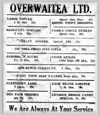 |
|
|

continued...
Hard rock mining suffered after the First World War, but by the mid 1920s, the industry had moved ahead. By 1930, only 5 mines accounted for 90 percent of British Columbia's production. The remaining 10 percent came from 125 other enteprises. Engineers also had difficulty finding work because not many people could afford them at this time. Fortunately for Ed Richardson and Ted Baynes, they were hired to plan the new town of Wells, British Columbia in 1934.
A night out at the movies in the 1930s cost 25 cents, and a newspaper cost 2 cents. Meanwhile, the governments increased taxes by 26.5 percent of the national income by 1933. Alcohol was also relatively expensive during this period; anyone caught drinking alcohol that was also collecting relief from the government was swiftly cut off.
The population in Canada dropped to its lowest point in the 1930s since the 1880s, and the birth rate dropped from 13.1 live births per 1000 in 1930 to only 9.7 by 1937. Although the population slowed in the rest of Canada during the 30s, Wells grew to almost 4500 people by the end of the decade. Due to misquided government policy, 4 western provinces collapsed financially. Jobless people were reduced to a degrading standard of living. Scurvy and other diet deficiency diseases were common.
Wells was a vibrant contrast to struggling towns in the rest of the country - hotels were overflowing, buildings were going up at a quick pace, and sawmills were run to capacity. Headlines in the Vancouver newspapers said it all: "The Depression is Banished", The Sunday Sun, Friday April 15 1933, and "Vancouver Excited By Two Gold Bricks From Cariboo Gold Quartz," with a picture of Fred Wells and the caption "Brought Home The Bacon", April 21,1933. Small wonder people travelled to Wells to risk their lives in dangerous mining jobs to survive this era of poverty.
Wells & the World | The Depression | World War II | Home | Meet the Team | Site Map
Last updated: September 8, 2000


